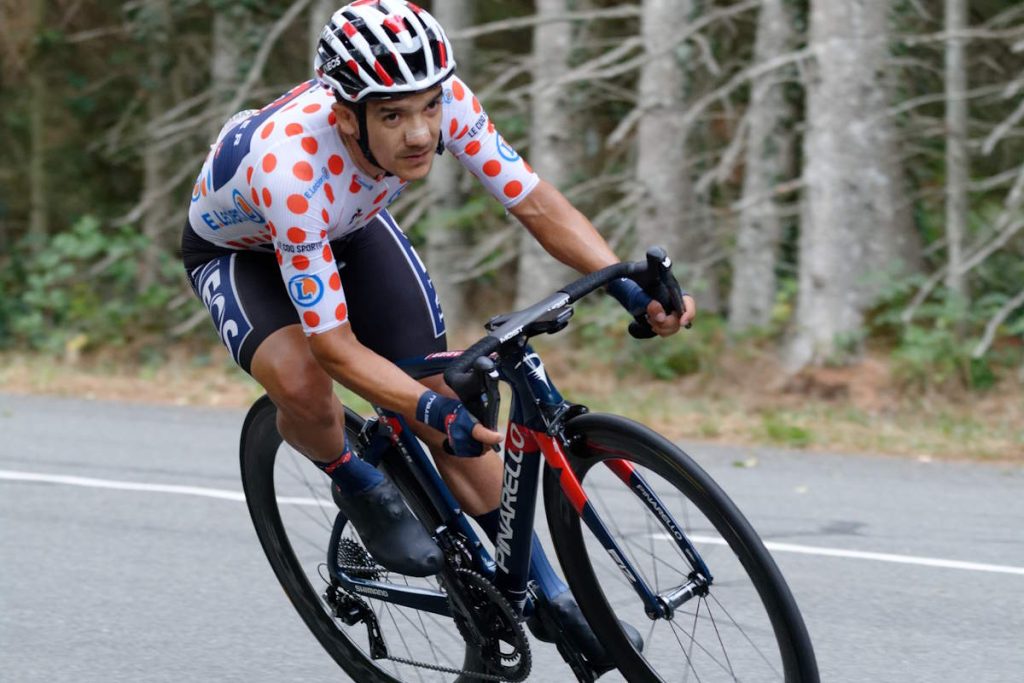The Tour de France is not just one race: it’s a race within many races. While the yellow jersey goes to the overall time leader, there’s a prestigious title awarded to the best climber: King of the Mountains. This coveted title celebrates the rider who dominates the high-altitude battles, conquering the steepest roads with a mix of strength, endurance, and courage.
Let’s dive into what it means to be the King of the Mountains, how the classification works, and its fascinating history.
King of the Mountains: The Climbers’ Crown in the Tour de France
The King of the Mountains (KOM) is the rider who earns the most points on categorized climbs throughout the Tour de France. These points are awarded at the summits of designated mountain climbs, with steeper and longer ascents offering more points.
The leader of this classification wears the white jersey with red polka dots, affectionately known as the polka-dot jersey (maillot à pois rouges in French).
A Brief History of the KOM Classification
The King of the Mountains title was first officially introduced in 1933, more than three decades after the Tour began in 1903. It was created to honor climbers-riders who may not win the overall Tour but dominate the mountain stages.
However, the polka-dot jersey itself wasn’t introduced until 1975. The idea came from Félix Lévitan, one of the Tour’s organizers. The unusual red-dot design was inspired by a sponsor at the time (a chocolate company called Chocolat Poulain), and it quickly became an iconic symbol of mountain mastery.
How Climbing Points Are Awarded
Not all climbs are equal, so climbs in the Tour de France are divided into categories, based on their:
- Steepness (gradient)
- Length
- Elevation gain
- Position within the stage (a climb near the finish is more decisive)
Here are the current categories:
- Hors Catégorie (HC): “Beyond categorization” – the hardest climbs, 20-40 points
- Category 1: Very difficult climbs, 10-20 points
- Category 2: Hard climbs, 5-10 points
- Category 3: Moderate climbs, 2-4 points
- Category 4: Small climbs, 1 point
In mountain stages, the points are doubled for summit finishes, making those stages critical in the KOM battle.
Tactics Behind the KOM Jersey
Riders targeting the King of the Mountains’ polka-dot jersey often aren’t contesting the overall yellow jersey (general classification). Instead, they specialize in aggressive climbing and often attack early on mountain stages to join breakaways and collect mountain points.
That said, sometimes yellow jersey contenders also win the KOM-especially in mountainous Tours-because they naturally accumulate climbing points en route to overall victory. This has happened with legends like Eddy Merckx, Gino Bartali, and more recently, Tadej Pogačar.
Legendary Kings of the Mountains
Some climbers have built their entire careers around mountain stages. Here are a few iconic polka-dot jersey winners:
- Richard Virenque (France): Holds the record with 7 KOM titles (1994-2004).
- Federico Bahamontes (Spain): Known as The Eagle of Toledo, he was the first to win both the KOM and the yellow jersey (1959).
- Lucien Van Impe (Belgium): Won the KOM six times and the overall Tour in 1976.
- Robert Millar (UK): The first Brit to win the polka-dot jersey (1984), later known as Philippa York.
These riders often gained a cult following for their fearless uphill attacks and underdog spirit.
Recent Trends and Modern Climbers
In recent years, the KOM battle has become more strategic, often influenced by team dynamics and the race for yellow. In 2020, Tadej Pogačar won the yellow, white, and polka-dot jerseys all at once-a rare and remarkable feat.
Other recent winners include:
- Rafal Majka (Poland) (2014, 2016)
- Warren Barguil (France) (2017)
- Julian Alaphilippe (France) (2018)
- Romain Bardet (France) (2019)
- Tadej Pogacar (Slovenia) (2020, 2021)
- Jonas Vingegaard (Denmark) (2022)
- Giulio Ciccone (Italy) (2023)
- Richard Carapaz (Equador) (2024)
In the modern Tour, the KOM contest still remains a thrilling subplot to the main event, giving solo breakaway riders and pure climbers a chance to shine.

Why the KOM Matters
Being crowned King of the Mountains is more than just wearing a flashy jersey-it’s a symbol of cycling’s most heroic quality: suffering and triumph on the hardest terrain. Mountains are where legends are made, and the red polka dots serve as proof that the rider has tamed the Tour’s most fearsome slopes.
For fans, mountain stages are among the most exciting and scenic parts of the race. They’re often where the crowds are thickest, the fans the loudest, and the attacks the most daring.
The polka-dot jersey may not be as globally recognized as the yellow jersey, but to many cycling enthusiasts, it represents the sport’s most awe-inspiring feats of endurance. Being the King of the Mountains means being fearless when the road tilts skyward and thriving where others falter.
In the Tour de France, every rider climbs-but only one wears the crown.
Sources
- “Mountains classification in the Tour de France” on Wikipedia
- UCI Elite Men Road Race World Champions: The Complete List [1927-2025] - September 28, 2025
- What Is Zone 2 In Cycling? - September 12, 2025
- The Turkish Flag at the Tour de France: Who’s Waving It at the Finish Line? - July 30, 2025

